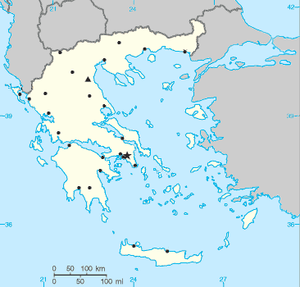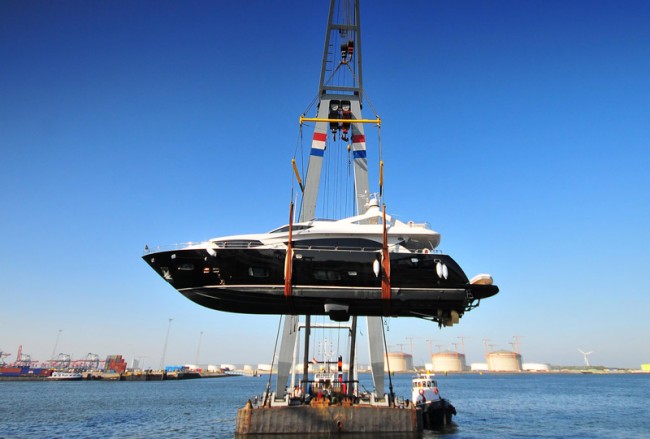The driver of the boat watches as the needle steadily climbs
past the 90s all the way to 100, and yet his hair isn't even messed up. This
must be the most effective windshield ever made, or at the least, a very
industrial Trump-worthy hairspray is being used. Actually, it’s neither because
the driver’s still at the dock aboard the new Four Winns 200 Horizon at Lake
Mead outside of
Las Vegas, Nevada, watching the dockside thermometer hit triple
figures while it’s still only morning.
It’s definitely time to get some air moving, so the driver cranks the key that
fires up the 280-hp, 5.7L Volvo Penta Gi with the single-prop SX outdrive. The
attractive Faria instrument layout with Newport four-in-one gauges includes the
usual suspects as well as a standard hour meter and digital depth sounder with
shallow-water alarm. The driver and co-pilot sit on bucket seats that feature
the Comfort- Ride inner-spring system, which gives you great support and has a
wraparound design that keeps you secure during extreme turns (more on that
later). The flip-up high-rise bolster seat gets the driver’s head above the windshield,
and on a day like today — with a rather long idle to open water — it’s much
appreciated. Speaking of windshields, the new 200 Horizon is the first in the
revamped lineup to get the sleek wraparound look with no braces in the corners
or sides for greater visibility, as well as enhanced aesthetics. On top of the
dash is a charcoal gray, non-reflective surface that is highly effective and
works to eliminate annoying “ghosts” from intruding into your vision.
Looking at the previous water levels on the canyon walls surrounding the lake
shows that graphically the water is way down — in fact, it’s at the lowest
level in 40 years. So despite being fairly deep in most spots, there are now
some new “reefs” that most boaters familiar with these waters haven’t had to
contend with. One hard and fast rule holds true here — if you see a bird
standing in the water, it would be a mistake to assume that it must have really
long legs. Even though the water’s low, Lake Mead still has almost 1.5 million
acres of runaround room for its estimated 8 million annual visitors.
Finally reaching open water, the driver summons forth all 280 horses and gets
the Horizon on plane in 4.5 seconds. It reaches 30 mph in a tick less than
eight, although both numbers would improve with the preferred Duoprop
configuration. Easing it up to 40 mph, the 200 is put through a series of hard
turns, which reveals its excellent handling. With the trim down, you can crank
the wheel all the way to its stops, and the boat still keeps turning, which is
pretty impressive. At slower speeds the 200 displays exceptional lateral
stability, and this is no accident. The story goes that one of the engineers
took his mom out for a ride, and while she thought the experience was OK, she
remarked that the boat’s rocking felt unstable and made her a bit
uncomfortable; that’s when the engineer’s mental light bulb clicked on. The
result is what Four Winns calls the Stable-Vee hull, which is its own take on
the variable deadrise design — sharper in front to handle the chop better,
flatter in the back for more stability and quicker planing.
Twin pods outboard on the extreme rear also help to minimize running surface
for a higher top speed, and the Horizon bears that out by reaching 51.5 mph
despite the heat and altitude out in Lost Wages. The only beef with the running
surface is the lack of trim tabs or the option to add them, but people (like
the author) who are determined to have them will find it easy to go to the
aftermarket and find inexpensive models that will keep the boat running level
even if your sumo-esque buddies all want to sit on the same side. With a length
of 20 feet 10 inches and a full 8-foot-6-inch beam, the 200 Horizon is roomier
than most in its class.
Four Winns fans will recognize the 200 Horizon name, but this one is vastly
improved. The most noticeable difference is the swim platform with a new
wide-step boarding ladder. Although the older model (introduced in 2001) has a
larger one, it was one of those bolted-on models and looked like it. The new
stern treatment on the new 200 is very elegantly integrated into the boat’s
lines. Another new feature is the stern walkthrough, which allows boarding
passengers to avoid stepping on the nice white Aquaflex vinyl that is soft to
the feel. The advantage here is that unlike thicker, stiffer vinyl, Aquaflex is
more resistant to cracking.
This boat is equipped with an optional wakeboard tower, which really gives it a
sporty and modern look. There are two different tower configurations, including
the deluxe, which gives you a Bimini top, board racks and two Tubby speakers
with subwoofer and amp that will take your sound system to the next level. But
even the standard four-speaker Clarion CD stereo (you will never see a cassette
player on a new Four Winns) with driver-side remote and one free year of
SIRIUS
satellite radio will satisfy all but the most hard core of headbangers.
Although no super-serious wakeboarder will mistake this boat for a tournament
ski boat, at 20 mph (the preferred speed for most wakeboarders) it puts out a
perfectly adequate jumping wake even with one person on board. If you invite
three or four friends or carry additional ballast, you won’t have any problem
catching some air. At higher speeds, slalom skiers will be treated to a fairly
flat wake. This, of course, definitely makes it a nice all-around ski boat for
the recreational crowd.
The Las Vegas test boat is decked out in the Sun Sport Configuration, which
gives you twin bucket seats, a stern bench, flip-up stern walkthrough, and a
larger-than-you-would-expect-for-a-20-footer sunning platform. The standard
layout provides a captain’s bucket and back-to-back fold-down seat for the
co-pilot. Twin jump seats in the corners of the stern can be raised flush to
create a sunpad, albeit an inferior version to the one on the Sun Sport. Up in
the bow, passengers have very comfortable seating with those facing forward
getting some backrest angle for comfort that even have storage behind them.
Taller riders won’t have a whole lot of stretch room due to the helm-forward
design that gives you an impressive amount of cockpit space. But a really nice
touch is the deluxe rearward facing bow seat, which is usually an afterthought
on most boats.
Of course, there is storage under the seats up front and in the stern, and
there are smaller compartments scattered all throughout the boat. There’s a
built-in cooler with overboard drain in the passenger console, and on the Sun
Sport model, you even have a second cooler with dedicated storage under the middle
of the stern seat bottom. The ski locker amidships has a hydraulic ram to hold
the lid up, giving you easy access to the relatively shallow compartment, which
has a rubber mat at the bottom. Seven cup holders are located throughout in
strategic locations, and for comfort there is 40-ounce snap-in carpet that
comes standard.
Manufacturer’s suggested retail for the 200 Horizon with the max-horsepower
5.7L Volvo Penta Gi engine is $39,162, and even without options it’s a nicely
equipped package. When customized with options like the wakeboard tower with
Bimini top, colored hull, cockpit table and Sun Sport seating with stern
walk-through, the price goes up to $43,331, counting the $1,031 destination
charge. While this price is considerably higher than a lot of other 20-footers,
you’re getting a boat that’s equipped and finished like you would expect to see
on a high-end boat with nice touches like an engine compartment that’s finished
with gel coat, premium CD stereo with satellite radio, tilt-steering, snap-in
carpeting, and dual axle Sure-Load trailer with disc brakes, just to name a
few. Over the past couple of years Four Winns has been updating its lineup to
embrace the Cross Stream Architecture, which blends the conveniences and
storage of a deck boat with the thrilling handling and styling of a sport boat.
The result: three cheers for Four Winns.
The Verdict:
Sporty, good-looking, and loaded with standard features, the 200 Horizon will
be a hit with recreational skiers or cruisers. Nimble handling and good
performance make this a fun boat to drive. Even as well-balanced as this boat
is, trim tabs should at least be available as an option, and do-it-yourself
mechanics will find the engine compartment a little tight on space.


























